
|
Now it is 6.5 mag (Oct. 13, Marco Goiato). It was expected to brighten up to 4-5 mag from autumn to winter. However, the brightness evolution has stopped in September. Now it is not observable. In the Northern Hemisphere, it will appear in the morning sky in late November, then it will be observable in excellent condition. In the Southern Hemisphere, it is hardly observable after this.
Date(TT) R.A. (2000) Decl. Delta r Elong. m1 Best Time(A, h)
Oct. 31 14 26.51 -25 41.7 1.822 0.875 11 6.3 18:32 ( 74,-23)
Nov. 7 14 24.41 -22 50.8 1.807 0.839 8 6.2 4:59 (286,-17)
|
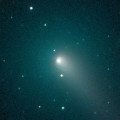
|
It brightened very rapidly. Now it is so bright as 9.2 mag (Nov. 1, Juan Jose Gonzalez). It is observable at 9-10 mag until next spring in excellent condition in the Northern Hemisphere. It keeps unobservable in the Southern Hemisphere.
Date(TT) R.A. (2000) Decl. Delta r Elong. m1 Best Time(A, h)
Oct. 31 16 19.99 76 34.1 1.872 2.152 92 9.5 18:32 (163, 38)
Nov. 7 16 24.45 73 21.3 1.878 2.136 90 9.4 18:27 (159, 37)
|
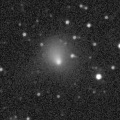
|
Now it is so bright as 10.5 mag (Nov. 1, Juan Jose Gonzalez). It will pass close to the earth from spring to summer in 2016, and it is expected to be observable at 6-7 mag in good condition. In the Northern Hemispehre, it keeps observable in excellent condition until winter. In the Southern Hemisphere, it keeps very low until winter.
Date(TT) R.A. (2000) Decl. Delta r Elong. m1 Best Time(A, h)
Oct. 31 4 21.18 45 16.2 1.879 2.710 139 11.2 1:48 (180, 80)
Nov. 7 3 50.16 45 32.1 1.745 2.636 147 10.9 0:50 (180, 79)
|

|
Now it is very bright as 9.5 mag (Oct. 14, Marco Goiato). In the Northern Hemisphere, it keeps very low in the evening until mid December. It will be getting lower gradually after this even in the Southern Hemisphere.
Date(TT) R.A. (2000) Decl. Delta r Elong. m1 Best Time(A, h)
Oct. 31 17 21.86 -22 20.2 2.110 1.559 44 11.0 18:32 ( 52, 11)
Nov. 7 17 45.00 -22 51.2 2.144 1.564 42 11.0 18:27 ( 51, 11)
|
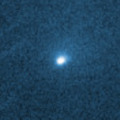
|
It brightened very rapidly. Now it is very bright as 11.1 mag (Oct. 9, Chris Wyatt). It keeps 11-13 mag until February. But it keeps very low in the Northern Hemisphere. It will be getting lower gradually after this even in the Southern Hemisphere.
Date(TT) R.A. (2000) Decl. Delta r Elong. m1 Best Time(A, h)
Oct. 31 17 57.55 -24 18.4 1.794 1.426 52 11.3 18:32 ( 44, 15)
Nov. 7 18 22.09 -25 0.6 1.817 1.420 50 11.2 18:27 ( 43, 15)
|

|
It brightened up to 3.7 mag and became a naked eye comet in mid January in 2015 (Jan. 13, Marek Biely). Now it is fading. But it is bright as 11.4 mag still now (Oct. 5, Katsumi Yoshimoto). In the Northern Hemisphere, it keeps observable for a long time until the comet fades out. It is not observable in the Southern Hemisphere.
Date(TT) R.A. (2000) Decl. Delta r Elong. m1 Best Time(A, h)
Oct. 31 16 48.50 26 34.3 4.255 3.764 54 12.2 18:32 (100, 34)
Nov. 7 16 56.04 25 18.9 4.364 3.835 52 12.3 18:27 (101, 31)
|

|
Now it is bright as 11.7 mag (Oct. 15, Juan Jose Gonzalez). It will be fading slowly after this. In the Northern Hemisphere, it keeps observable in good condition. In the Southern Hemisphere, it keeps low until November.
Date(TT) R.A. (2000) Decl. Delta r Elong. m1 Best Time(A, h)
Oct. 31 10 46.05 14 8.3 1.806 1.560 59 12.5 4:54 (283, 41)
Nov. 7 11 1.24 12 56.4 1.799 1.608 62 12.7 4:59 (287, 44)
|
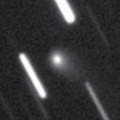
|
Now it is bright as 12.8 mag (Oct. 15, Juan Jose Gonzalez). It keeps 13 mag for a long time from 2015 autumn to 2016 summer. In the Northern Hemispehre, it keeps observable in good condition for a long time. It keeps unobservable in the Southern Hemisphere.
Date(TT) R.A. (2000) Decl. Delta r Elong. m1 Best Time(A, h)
Oct. 31 8 28.57 76 39.3 2.618 3.001 102 13.6 4:54 (185, 48)
Nov. 7 9 5.21 79 59.5 2.554 2.969 104 13.5 4:59 (184, 45)
|

|
It tends to brighten very rapidly around the perihelion passage. It will brighten up to 11 mag from November to December. It will appear in the evening sky in early December, then it will fade out very rapidly.
Date(TT) R.A. (2000) Decl. Delta r Elong. m1 Best Time(A, h)
Oct. 31 14 39.71 -16 10.0 1.731 0.749 5 14.7 18:32 ( 80,-15)
Nov. 7 15 17.15 -17 56.4 1.622 0.653 7 13.6 18:27 ( 77,-13)
|

|
It is fading, but bright as 13.2 mag still now (Oct. 13, Katsumi Yoshimoto). It keeps observable until March when the comet becomes fainter than 18 mag.
Date(TT) R.A. (2000) Decl. Delta r Elong. m1 Best Time(A, h)
Oct. 31 2 12.38 10 28.3 1.435 2.427 176 13.7 23:34 ( 0, 66)
Nov. 7 2 5.05 10 5.9 1.493 2.472 168 13.9 22:59 ( 0, 65)
|
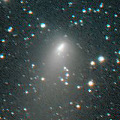
|
It brightened rapidly up to 10.4 mag from July to August (July 18, Maik Meyer). Now it is fading, but it is bright as 13.2 mag still now (Oct. 11, Seiichi Yoshida). It is observable in good condition in the Northern Hemisphere. It is not observable in the Southern Hemisphere.
Date(TT) R.A. (2000) Decl. Delta r Elong. m1 Best Time(A, h)
Oct. 31 19 46.90 46 13.3 1.610 1.958 94 13.8 18:32 (132, 71)
Nov. 7 20 2.69 46 21.6 1.673 2.007 94 14.1 18:27 (131, 70)
|

|
Outburst occured on Sept. 22. It is bright as 12.5 mag still now (Oct. 4, Thomas Lehmann).
Date(TT) R.A. (2000) Decl. Delta r Elong. m1 Best Time(A, h)
Oct. 31 17 45.49 -28 43.1 6.584 5.994 49 13.9 18:32 ( 44, 10)
Nov. 7 17 50.72 -28 37.3 6.663 5.992 44 14.0 18:27 ( 47, 8)
|
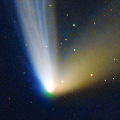
|
It approached to the sun down to 0.3 a.u. on July 6, and brighted up to 3.9 mag (July 6, Thomas Lehmann). Now it is fading. It has already faded down to 12.9 mag (Oct. 3, Chris Wyatt). In the Northern Hemisphere, it keeps observable until the comet fades out. It will not be observable after this in the Northern Hemisphere.
Date(TT) R.A. (2000) Decl. Delta r Elong. m1 Best Time(A, h)
Oct. 31 15 40.64 -51 59.9 2.999 2.349 41 13.9 18:32 ( 41,-22)
Nov. 7 16 0.04 -52 51.0 3.133 2.452 39 14.2 18:27 ( 41,-23)
|

|
Now it is 14.2 mag (Oct. 15, Taras Prystavski). Distant object, but it keeps observable at 14-15 mag for a long time from 2015 to 2016.
Date(TT) R.A. (2000) Decl. Delta r Elong. m1 Best Time(A, h)
Oct. 31 21 14.60 -7 16.9 4.818 5.112 101 14.5 18:38 ( 0, 48)
Nov. 7 21 17.30 -7 31.1 4.910 5.098 95 14.5 18:27 ( 5, 47)
|

|
Now it is 14.2 mag (Oct. 11, Hidetaka Sato). In the Northern Hemisphere, it keeps observable after this while the comet will be fading. It is not observable in the Southern Hemisphere until January when the comet will fade down to 16 mag.
Date(TT) R.A. (2000) Decl. Delta r Elong. m1 Best Time(A, h)
Oct. 31 12 24.47 22 52.4 2.709 2.144 46 14.5 4:54 (259, 26)
Nov. 7 12 38.22 22 10.6 2.706 2.195 49 14.7 4:59 (262, 29)
|

|
Appearing in the morning sky in the Northern Hemisphere. It will be observable after December in the Southern Hemisphere. It is expected to brighten up to 13 mag from winter to spring. It will be observable in excellent condition in the Southern Hemisphere. But it locates somewhat low in the Northern Hemisphere.
Date(TT) R.A. (2000) Decl. Delta r Elong. m1 Best Time(A, h)
Oct. 31 12 13.96 0 3.2 3.001 2.246 33 14.7 4:54 (281, 15)
Nov. 7 12 27.31 -1 28.2 2.943 2.236 37 14.6 4:59 (285, 18)
|

|
First return of a periodic comet which brightened up to 8 mag in major outburst in 2010. It will be observable in excellent condition from winter to spring. Now it is not detected, fainter than 20 mag (Oct. 2, Jean-Francois Soulier).
Date(TT) R.A. (2000) Decl. Delta r Elong. m1 Best Time(A, h)
Oct. 31 8 40.24 30 1.8 1.598 1.915 92 15.1 4:54 (283, 74)
Nov. 7 8 55.55 29 37.9 1.500 1.882 95 14.6 4:59 (292, 78)
|
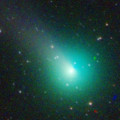
|
It brightened up to 6.0 mag in mid May (May 14, Chris Wyatt). Now it is fading. It has already faded down to 14.5 mag (Oct. 11, Seiichi Yoshida). In the Northern Hemisphere, it keeps observable in good condition after this while the comet will be fading. It locates somewhat low in the Southern Hemisphere.
Date(TT) R.A. (2000) Decl. Delta r Elong. m1 Best Time(A, h)
Oct. 31 8 22.24 26 53.5 2.398 2.681 95 14.7 4:54 (302, 76)
Nov. 7 8 13.10 28 31.4 2.346 2.768 104 14.8 4:59 (339, 83)
|
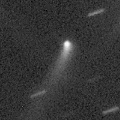
|
Now it is 14.5 mag (Oct. 15, Taras Prystavski). It will be fading slowly after this. In the Northern Hemisphere, it keeps observable for a long time until the comet fades out. In the Southern Hemisphere, it will be low after this.
Date(TT) R.A. (2000) Decl. Delta r Elong. m1 Best Time(A, h)
Oct. 31 1 17.54 15 3.8 3.239 4.206 165 15.1 22:39 ( 0, 70)
Nov. 7 1 5.13 15 3.9 3.290 4.213 155 15.2 21:59 ( 0, 70)
|
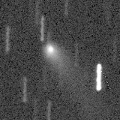
|
Now it is 14.1 mag (Oct. 7, Taras Prystavski). It keeps 15 mag for a long time from 2014 to 2015. It is observable in excellent condition in the Northern Hemisphere. It locates low in the Southern Hemisphere.
Date(TT) R.A. (2000) Decl. Delta r Elong. m1 Best Time(A, h)
Oct. 31 1 11.96 46 56.1 3.525 4.368 144 15.1 22:33 (180, 78)
Nov. 7 1 2.92 47 5.7 3.569 4.395 142 15.2 21:57 (180, 78)
|

|
First return of a periodic comet discovered in 1994. It brightened up to 13.8 mag from summer to autumn (Sept. 7, Taras Prystavski). Now it is fading, but it is bright as 15.3 mag still now (Oct. 16, Taras Prystavski). It is observable in excellent condition in the Southern Hemisphere. It locates somewhat low in the Northern Hemisphere.
Date(TT) R.A. (2000) Decl. Delta r Elong. m1 Best Time(A, h)
Oct. 31 22 36.84 -26 4.7 1.886 2.449 112 15.2 20:00 ( 0, 29)
Nov. 7 22 40.72 -24 18.9 1.961 2.452 107 15.3 19:36 ( 0, 31)
|
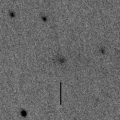
|
It will be observable at 14 mag from winter to summer. It will be observable in excellent condition in the Southern Hemisphere. It locates low in the Northern Hemisphere.
Date(TT) R.A. (2000) Decl. Delta r Elong. m1 Best Time(A, h)
Oct. 31 12 24.75 3 12.1 3.187 2.415 33 15.3 4:54 (277, 15)
Nov. 7 12 37.90 1 22.1 3.114 2.387 36 15.2 4:59 (281, 18)
|
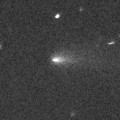
|
Now it is 14.7 mag (Oct. 13, Mitsunori Tsumura). It keeps observable at 15 mag in good condition for a while.
Date(TT) R.A. (2000) Decl. Delta r Elong. m1 Best Time(A, h)
Oct. 31 2 21.64 4 37.8 1.140 2.126 170 15.3 23:43 ( 0, 60)
Nov. 7 2 17.71 4 4.8 1.156 2.132 166 15.3 23:12 ( 0, 59)
|
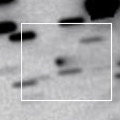
|
Now it is 16.6 mag (Oct. 16, D. Buczynski). It will brighten up to 11 mag from spring to summer in 2016. In the Northern Hemisphere, it keeps observable in good condition while the comet will be brightening. It locates somewhat low in the Southern Hemisphere.
Date(TT) R.A. (2000) Decl. Delta r Elong. m1 Best Time(A, h)
Oct. 31 6 5.80 19 38.3 2.099 2.796 125 15.6 3:31 ( 0, 75)
Nov. 7 6 5.60 19 32.1 1.986 2.756 132 15.4 3:04 ( 0, 75)
|

|
Now it is 14.3 mag (Oct. 13, Taras Prystavski). It keeps 15-16 mag for a long time until 2016. It keeps observable in excellent condition in the Northern Hemisphere. It keeps unobservable in the Southern Hemisphere.
Date(TT) R.A. (2000) Decl. Delta r Elong. m1 Best Time(A, h)
Oct. 31 5 28.19 68 20.8 4.651 5.188 117 15.5 2:55 (180, 57)
Nov. 7 5 20.65 69 46.7 4.606 5.190 121 15.5 2:20 (180, 55)
|

|
Now it is 15.0 mag (Oct. 2, Taras Prystavski). It will be unobservable in early December in the Southern Hemisphere, or in early January in the Northern Hemisphere.
Date(TT) R.A. (2000) Decl. Delta r Elong. m1 Best Time(A, h)
Oct. 31 19 46.55 -14 43.5 4.012 3.943 78 15.6 18:32 ( 25, 37)
Nov. 7 19 53.38 -14 45.1 4.139 3.974 73 15.7 18:27 ( 29, 35)
|
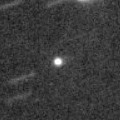
|
Now it is 15.8 mag (Oct. 20, K. Hills). It is expected to brighten rapidly, and to be observable at 14.5 mag in good condition in autumn.
Date(TT) R.A. (2000) Decl. Delta r Elong. m1 Best Time(A, h)
Oct. 31 5 5.36 -9 30.0 0.635 1.498 132 15.8 2:31 ( 0, 46)
Nov. 7 5 10.08 -9 13.9 0.606 1.490 136 15.6 2:08 ( 0, 46)
|

|
It brightened up to 13 mag in 2014. Now it is 15.1 mag (Oct. 15, Taras Prystavski). It will be fading slowly after this. It is observable at 16 mag in excellent condition from summer to winter in 2015.
Date(TT) R.A. (2000) Decl. Delta r Elong. m1 Best Time(A, h)
Oct. 31 1 6.55 -0 36.3 3.050 3.983 157 16.2 22:28 ( 0, 54)
Nov. 7 1 2.85 -0 43.3 3.113 3.999 149 16.3 21:57 ( 0, 54)
|

|
It brightened up to 11-12 mag in 2012. It has already faded down to 16.5 mag (July 9, Taras Prystavski). Appearing in the morning sky. It is observable at 16 mag in good condition from winter to spring.
Date(TT) R.A. (2000) Decl. Delta r Elong. m1 Best Time(A, h)
Oct. 31 11 16.52 -6 18.1 11.050 10.377 45 16.3 4:54 (296, 22)
Nov. 7 11 17.11 -6 29.7 10.995 10.414 52 16.3 4:59 (302, 28)
|

|
It brightened rapidly in mid August, and brightened up to 10.8 mag (Sept. 13, Sandor Szabo). Secondary component H also brightened up to 14.8 mag (Sept. 13, Thomas Lehmann). Now it is fading very rapidly. It has already faded down to 16.5 mag (Oct. 15, Taras Prystavski). In the Northern Hemisphere, it keeps observable in good condition in the morning sky. In the Southern Hemisphere, it keeps locating extremely low from summer to autumn.
Date(TT) R.A. (2000) Decl. Delta r Elong. m1 Best Time(A, h)
Oct. 31 10 41.45 -1 15.7 1.576 1.297 55 16.5 4:54 (298, 32)
Nov. 7 10 53.41 -3 23.6 1.601 1.375 58 17.1 4:59 (305, 34)
|
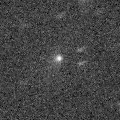
|
Now it is 16.7 mag (Oct. 11, A. Diepvens). It is observable at 16-17 mag in good condition from October to December in the Northern Hemisphere. It is not observable in the Southern Hemisphere.
Date(TT) R.A. (2000) Decl. Delta r Elong. m1 Best Time(A, h)
Oct. 31 3 11.27 84 1.4 1.555 2.108 109 16.6 0:46 (180, 41)
Nov. 7 1 54.78 79 29.1 1.505 2.137 116 16.6 22:47 (180, 46)
|

|
It brightened up to 6.9 mag in 2014 autumn (Oct. 17, Marco Goiato). Now it is fading. It has already faded down to 15.3 mag (Oct. 3, Taras Prystavski). In the Southern Hemisphere, it keeps observable in good condition until the comet fades out. In the Northern Hemisphere, it keeps observable until winter, but it locates somewhat low.
Date(TT) R.A. (2000) Decl. Delta r Elong. m1 Best Time(A, h)
Oct. 31 22 45.27 -28 35.2 4.935 5.404 113 16.6 20:08 ( 0, 27)
Nov. 7 22 41.44 -28 14.2 5.112 5.470 106 16.7 19:36 ( 0, 27)
|
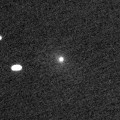
|
Now it is 16.1 mag (Oct. 14, Yasukazu Ikari). It keeps observable in good condition until the comet fades out. In 2014, it must have been observable at 14 mag in good condition in the Southern Hemisphere.
Date(TT) R.A. (2000) Decl. Delta r Elong. m1 Best Time(A, h)
Oct. 31 0 1.43 2 46.7 3.748 4.591 144 16.8 21:24 ( 0, 58)
Nov. 7 23 58.90 2 55.0 3.871 4.643 136 16.9 20:54 ( 0, 58)
|

|
Now it is 16.7 mag (Oct. 4, Taras Prystavski). It will brighten up to 14 mag in 2016 summer. But it is not observable at the highlight. It keeps observable until March while the comet will be brightening gradually up to 15-16 mag.
Date(TT) R.A. (2000) Decl. Delta r Elong. m1 Best Time(A, h)
Oct. 31 0 20.12 -7 17.3 1.752 2.620 143 16.9 21:42 ( 0, 48)
Nov. 7 0 17.13 -7 38.2 1.782 2.590 136 16.9 21:12 ( 0, 47)
|
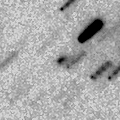
|
Now it is 16.8 mag (Oct. 17, K. Hills). It is observable at 17 mag in excellent condition in autumn.
Date(TT) R.A. (2000) Decl. Delta r Elong. m1 Best Time(A, h)
Oct. 31 6 18.56 -2 57.3 1.119 1.813 118 16.9 3:44 ( 0, 52)
Nov. 7 6 21.54 -5 32.3 1.095 1.830 122 16.9 3:19 ( 0, 50)
|
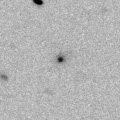
|
Now it is 16.9 mag (Oct. 10, Taras Prystavski). It will be fading after this. It will be fainter than 18 mag at the end of 2015.
Date(TT) R.A. (2000) Decl. Delta r Elong. m1 Best Time(A, h)
Oct. 31 23 28.31 -8 34.3 1.703 2.481 132 16.9 20:51 ( 0, 47)
Nov. 7 23 30.41 -8 21.0 1.773 2.486 125 17.0 20:26 ( 0, 47)
|
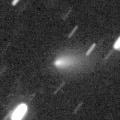
|
It was so faint as 20.0 mag in August (Aug. 17, Hidetaka Sato). However, it brightened by 6 mag in outburst in mid September, and brightened up to 13.7 mag (Sept. 21, Seiichi Yoshida). Now it is fading rapidly. It has already faded down to 16.1 mag (Oct. 19, Taras Prystavski). It keeps observable in excellent condition for a while.
Date(TT) R.A. (2000) Decl. Delta r Elong. m1 Best Time(A, h)
Oct. 31 4 46.73 1 8.9 1.392 2.253 141 17.1 2:12 ( 0, 56)
Nov. 7 4 41.29 0 7.8 1.399 2.297 147 17.5 1:40 ( 0, 55)
|
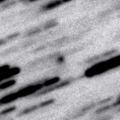
|
It brightened up to 16.4 mag in 2014 (Nov. 14, J. F. Hernandez). Now it is 17.0 mag (Oct. 20, Purple Mountain Observatory). It keeps observable in good condition for a while. But it will be fainter than 18 mag in January.
Date(TT) R.A. (2000) Decl. Delta r Elong. m1 Best Time(A, h)
Oct. 31 4 17.16 28 17.0 1.763 2.663 148 17.1 1:43 ( 0, 83)
Nov. 7 4 11.78 28 0.7 1.751 2.692 156 17.1 1:10 ( 0, 83)
|
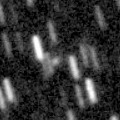
|
Now it is 16.8 mag (Oct. 19, Hidetaka Sato). It keeps 16.5 mag for a long time in 2016, and it will be observable in excellent condition in the Southern Hemisphere. It is hardly observable in the Northern Hemisphere.
Date(TT) R.A. (2000) Decl. Delta r Elong. m1 Best Time(A, h)
Oct. 31 8 59.62 -44 15.0 3.964 3.796 73 17.3 4:54 (344, 8)
Nov. 7 8 55.96 -46 45.6 3.869 3.768 76 17.2 4:59 (351, 7)
|
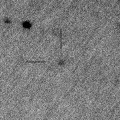
|
Now it is 18.2 mag (Oct. 18, H. Nohara). Now it is near the aphelion. It is observable at 17 mag in good condition from autumn to winter.
Date(TT) R.A. (2000) Decl. Delta r Elong. m1 Best Time(A, h)
Oct. 31 3 42.80 16 4.0 3.357 4.301 159 17.3 1:09 ( 0, 71)
Nov. 7 3 38.53 15 54.0 3.320 4.293 167 17.3 0:37 ( 0, 71)
|

|
First return of a periodic comet discovered in 2003. Now it is 18.1 mag (Oct. 11, J.-F. Soulier). It will approach to the earth from autumn to winter, and it was expected to brighten up to 15 mag and observable in excellent condition. But actually, it is fainter than expected by 1.5 mag.
Date(TT) R.A. (2000) Decl. Delta r Elong. m1 Best Time(A, h)
Oct. 31 4 58.47 -4 52.4 0.844 1.705 136 17.4 2:24 ( 0, 50)
Nov. 7 4 59.58 -3 31.6 0.796 1.689 141 17.3 1:57 ( 0, 51)
|

|
Now it is 16.5 mag (Oct. 4, Taras Prystavski). It is fading, but it is a bit brighter than this ephemeris. The fragments B and C are already fainter than 20 mag (June 12, Takaaki Oribe).
Date(TT) R.A. (2000) Decl. Delta r Elong. m1 Best Time(A, h)
Oct. 31 22 38.12 -2 31.3 6.128 6.720 122 17.3 20:01 ( 0, 53)
Nov. 7 22 36.18 -3 12.9 6.283 6.766 115 17.4 19:31 ( 0, 52)
|
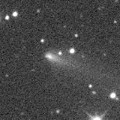
|
Now it is 15.3 mag (Oct. 10, Taras Prystavski). It keeps observable in good condition for a while. But it will be fading after this, and will be fainter than 18 mag in November.
Date(TT) R.A. (2000) Decl. Delta r Elong. m1 Best Time(A, h)
Oct. 31 0 0.40 -0 32.6 1.363 2.236 142 17.4 21:23 ( 0, 55)
Nov. 7 0 0.87 -0 38.9 1.452 2.272 135 17.6 20:56 ( 0, 54)
|

|
It will brighten rapidly after this, and it will be observable at 14-15 mag in good condition from winter to summer.
Date(TT) R.A. (2000) Decl. Delta r Elong. m1 Best Time(A, h)
Oct. 31 11 53.07 14 37.4 3.251 2.658 45 17.5 4:54 (271, 28)
Nov. 7 12 3.37 13 15.5 3.166 2.638 49 17.4 4:59 (276, 32)
|
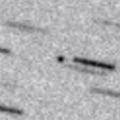
|
Now it is 17.1 mag (Oct. 22, C. Bell). It is observable in good condition in the Northern Hemisphere. It is not observable in the Southern Hemisphere.
Date(TT) R.A. (2000) Decl. Delta r Elong. m1 Best Time(A, h)
Oct. 31 10 20.73 40 28.1 1.680 1.754 77 17.4 4:54 (248, 56)
Nov. 7 10 36.32 40 45.8 1.670 1.804 81 17.5 4:59 (248, 59)
|
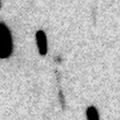
|
First return of a periodic comet discovered in 1998. Now it is 17.9 mag (Oct. 3, J. V. Scotti). It will be observable at 17.5 mag from autumn to winter.
Date(TT) R.A. (2000) Decl. Delta r Elong. m1 Best Time(A, h)
Oct. 31 21 14.29 -13 44.8 1.521 1.952 99 17.5 18:38 ( 0, 41)
Nov. 7 21 22.33 -12 0.5 1.577 1.936 95 17.5 18:27 ( 3, 43)
|

|
Now it is 16.5 mag (Sept. 8, Jean-Francois Soulier). It has brightened in outburst up to 14 mag twice, in 2006 January and 2011 May. It is around the perihelion now. It keeps observable at 17 mag for a long time after this.
Date(TT) R.A. (2000) Decl. Delta r Elong. m1 Best Time(A, h)
Oct. 31 23 3.49 -5 57.0 5.230 5.889 127 17.5 20:26 ( 0, 49)
Nov. 7 23 3.28 -6 1.6 5.328 5.894 120 17.6 19:58 ( 0, 49)
|
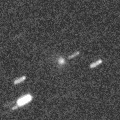
|
Now it is 17.3 mag (Oct. 10, Taras Prystavski). It was expected to be observable at 16 mag in good condition from summer to winter. But actually, it is fainter than originally predicted, and it will be 17.5 mag at best.
Date(TT) R.A. (2000) Decl. Delta r Elong. m1 Best Time(A, h)
Oct. 31 22 30.71 -6 7.1 1.436 2.116 120 17.5 19:53 ( 0, 49)
Nov. 7 22 31.99 -4 48.9 1.484 2.091 113 17.6 19:27 ( 0, 50)
|
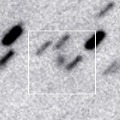
|
Now it is 17.3 mag (Oct. 21, A. Maury, J.-F. Soulier, J.-G. Bosch, T. Noel). It keeps 17.5 mag for a long time from 2016 to 2019. It keeps locating near by the equator.
Date(TT) R.A. (2000) Decl. Delta r Elong. m1 Best Time(A, h)
Oct. 31 8 15.01 -0 22.4 10.210 10.272 90 17.7 4:54 (341, 53)
Nov. 7 8 15.73 -0 32.2 10.087 10.258 97 17.6 4:59 (354, 54)
|
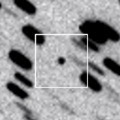
|
Now it is 18.0 mag (Oct. 10, Jean-Francois Soulier). Now it is around the aphelion. It is observable at 17.5 mag in excellent condition in autumn in the Northern Hemisphere. It locates low in the Southern Hemisphere.
Date(TT) R.A. (2000) Decl. Delta r Elong. m1 Best Time(A, h)
Oct. 31 2 55.74 41 33.1 1.460 2.379 151 17.7 0:23 (180, 83)
Nov. 7 2 36.99 40 17.5 1.450 2.388 155 17.6 23:30 (180, 85)
|

|
It will pass the perihelion in 2019. However, it has not been brightening since the discovery in 2010. Now it is 18.0 mag (Oct. 6, Yasukazu Ikari). It keeps observable in excellent condition from autumn to next spring in the Northern Hemisphere. It is not observable in the Southern Hemisphere.
Date(TT) R.A. (2000) Decl. Delta r Elong. m1 Best Time(A, h)
Oct. 31 3 40.61 47 22.0 10.173 10.977 142 17.7 1:07 (180, 78)
Nov. 7 3 37.47 47 33.5 10.109 10.952 146 17.7 0:36 (180, 77)
|

|
Now it is 18.6 mag (Oct. 11, Hidetaka Sato). It is observable at 17 mag in good condition in winter.
Date(TT) R.A. (2000) Decl. Delta r Elong. m1 Best Time(A, h)
Oct. 31 7 59.91 11 58.0 2.083 2.419 97 17.9 4:54 (341, 66)
Nov. 7 8 6.66 12 2.1 1.989 2.409 102 17.8 4:59 (357, 67)
|
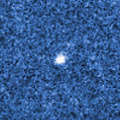
|
Now it is 18.1 mag (Oct. 15, A. Maury, J.-F. Soulier, J.-G. Bosch, T. Noel). It will brighten up to 16 mag in 2016 summer. In the Southern Hemisphere, it keeps observable in good condition for a long time. In the Northern Hemisphere, it is observable only until next March.
Date(TT) R.A. (2000) Decl. Delta r Elong. m1 Best Time(A, h)
Oct. 31 5 46.53 -2 27.4 2.714 3.394 125 18.0 3:12 ( 0, 53)
Nov. 7 5 41.01 -5 3.9 2.597 3.342 131 17.8 2:39 ( 0, 50)
|
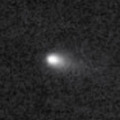
|
It brightened up to 15.9 mag in June as predicted (June 23, Ken-ichi Kadota). It was expected to be observable at 13 mag in good condition from summer to autumn. However, Jean-Gabriel Bosch detected the comet became disintegrating in July. Now it is so faint as 20.1 mag (Oct. 15, Pan-STARRS 1, Haleakala). The fragment D and B are also observed as 19.0 mag (Sept. 20, Michael Jager) and 20.9 mag (Aug. 21, Pan-STARRS 1, Haleakala) respectively.
Date(TT) R.A. (2000) Decl. Delta r Elong. m1 Best Time(A, h)
Oct. 31 2 8.17 3 37.1 0.876 1.861 169 19.4 23:30 ( 0, 59)
Nov. 7 2 4.03 3 57.7 0.916 1.889 164 19.6 22:58 ( 0, 59)
|
|
![]()
 88P/Howell
88P/Howell C/2015 F4 ( Jacques )
C/2015 F4 ( Jacques ) 29P/Schwassmann-Wachmann 1
29P/Schwassmann-Wachmann 1 C/2014 Q1 ( PanSTARRS )
C/2014 Q1 ( PanSTARRS ) C/2011 KP36 ( Spacewatch )
C/2011 KP36 ( Spacewatch ) 19P/Borrelly
19P/Borrelly 116P/Wild 4
116P/Wild 4 P/2010 V1 ( Ikeya-Murakami )
P/2010 V1 ( Ikeya-Murakami ) C/2015 G2 ( MASTER )
C/2015 G2 ( MASTER ) C/2014 A4 ( SONEAR )
C/2014 A4 ( SONEAR ) C/2014 N3 ( NEOWISE )
C/2014 N3 ( NEOWISE ) 318P/2014 M6 ( McNaught-Hartley )
318P/2014 M6 ( McNaught-Hartley ) C/2014 Y1 ( PanSTARRS )
C/2014 Y1 ( PanSTARRS ) 61P/Shajn-Schaldach
61P/Shajn-Schaldach 81P/Wild 2
81P/Wild 2 C/2013 V4 ( Catalina )
C/2013 V4 ( Catalina ) C/2012 F3 ( PanSTARRS )
C/2012 F3 ( PanSTARRS ) 230P/LINEAR
230P/LINEAR 117P/Helin-Roman-Alu 1
117P/Helin-Roman-Alu 1 C/2006 S3 ( LONEOS )
C/2006 S3 ( LONEOS ) 141P/Machholz 2
141P/Machholz 2 C/2015 GX ( PanSTARRS )
C/2015 GX ( PanSTARRS ) C/2012 K1 ( PanSTARRS )
C/2012 K1 ( PanSTARRS ) C/2015 K1 ( MASTER )
C/2015 K1 ( MASTER ) 118P/Shoemaker-Levy 4
118P/Shoemaker-Levy 4 P/2015 Q1 ( Scotti )
P/2015 Q1 ( Scotti ) 151P/Helin
151P/Helin 205P/Giacobini
205P/Giacobini 44P/Reinmuth 2
44P/Reinmuth 2 C/2015 B2 ( PanSTARRS )
C/2015 B2 ( PanSTARRS ) 74P/Smirnova-Chernykh
74P/Smirnova-Chernykh 329P/2015 T1 ( LINEAR-Catalina )
329P/2015 T1 ( LINEAR-Catalina ) C/2011 J2 ( LINEAR )
C/2011 J2 ( LINEAR ) 57P/du Toit-Neujmin-Delporte
57P/du Toit-Neujmin-Delporte 77P/Longmore
77P/Longmore 162P/Siding Spring
162P/Siding Spring 328P/2015 S1 ( LONEOS-Tucker )
328P/2015 S1 ( LONEOS-Tucker ) 174P/(60558) 2000 EC98 ( Echeclus )
174P/(60558) 2000 EC98 ( Echeclus ) 50P/Arend
50P/Arend C/2014 B1 ( Schwartz )
C/2014 B1 ( Schwartz ) (3200) Phaethon
(3200) Phaethon C/2010 U3 ( Boattini )
C/2010 U3 ( Boattini ) 211P/Hill
211P/Hill C/2015 T4 ( PanSTARRS )
C/2015 T4 ( PanSTARRS ) 51P/Harrington
51P/Harrington![]()
















































